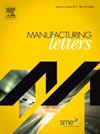基于颗粒图像测速的摩擦搅拌过程中塑性材料流动和界面状态的原位观察
IF 2
Q3 ENGINEERING, MANUFACTURING
引用次数: 0
摘要
摩擦搅拌工艺在避免焊接和增材制造应用中与固化相关的缺陷方面具有独特的优势。这些过程涉及复杂的材料塑性流动,这对产品的微观结构和性能至关重要,但尚未得到很好的理解。定量测量的缺乏进一步阻碍了塑性与摩擦引起的加热分析之间的定量区分。因此,这项工作提出了一项实验工作,以可视化和量化搅拌摩擦点焊过程中的材料流动和摩擦行为。采用光学透明的聚甲基丙烯酸甲酯(PMMA)作为底物,并在工具-材料界面放置示踪颗粒以可视化塑料流动。采用粒子图像测速(PIV)算法对流速进行量化。该实验首次直接揭示了刀具-材料界面上的粘滑主导区及其沿刀具径向的过渡。将结果与基于物理的分析模型进行比较,以了解加工条件对材料变形机制和塑性流动行为的影响。本文章由计算机程序翻译,如有差异,请以英文原文为准。
In-situ observation of plastic material flow and interfacial condition in friction stir-based processes via particle image velocimetry
Friction stir processes exhibit unique advantages in avoiding solidification-related defects in welding and additive manufacturing applications. These processes involve complex plastic flow of materials, which are critical for the product microstructure and properties but have not been well understood. The lack of quantitative measurements further prevents the quantitative distinction between plasticity versus friction induced heating analysis. This work thus presents an experimental work to visualize and quantify the material flow and frictional behavior under a friction stir spot welding process. Optically transparent polymethyl methacrylate (PMMA) was used as the substrate, and tracer particles were placed at the tool-material interface to visualize the plastic flow. The particle image velocimetry (PIV) algorithm was used to quantify the flow velocity. The experiments, for the first time, directly revealed the stick- and slip-dominant zones on the tool-material interface and their transition along the tool radial direction. The results were compared with a physics-based analytical model to understand the effects of processing conditions on the material deformation mechanisms and plastic flow behavior in the process.
求助全文
通过发布文献求助,成功后即可免费获取论文全文。
去求助
来源期刊

Manufacturing Letters
Engineering-Industrial and Manufacturing Engineering
CiteScore
4.20
自引率
5.10%
发文量
192
审稿时长
60 days
 求助内容:
求助内容: 应助结果提醒方式:
应助结果提醒方式:


